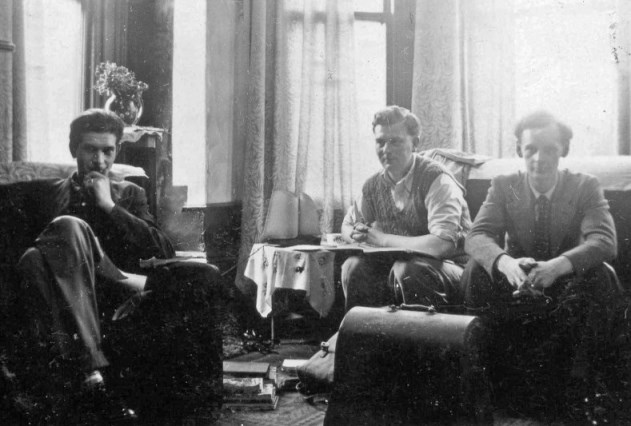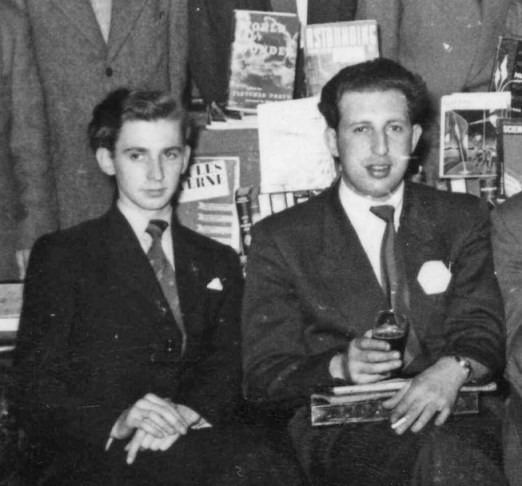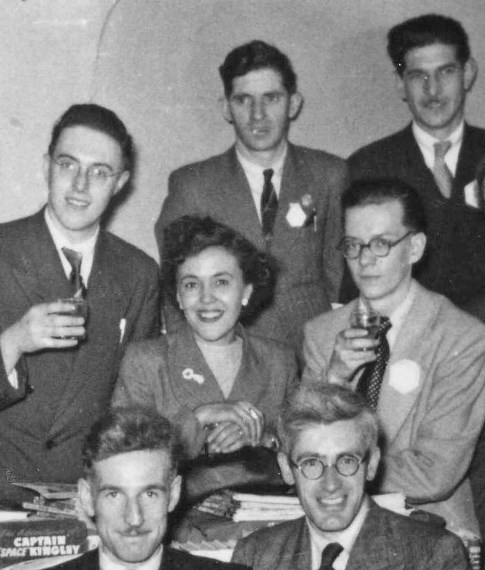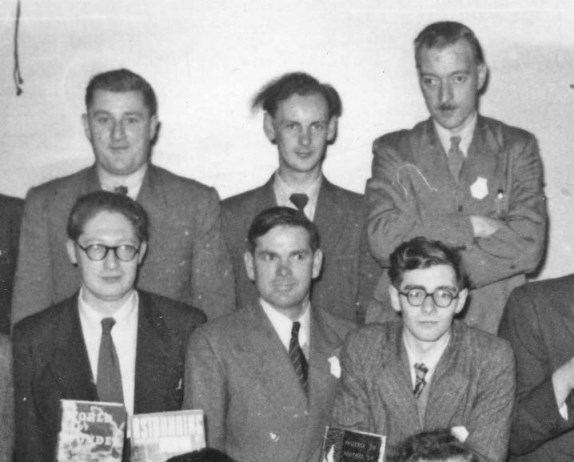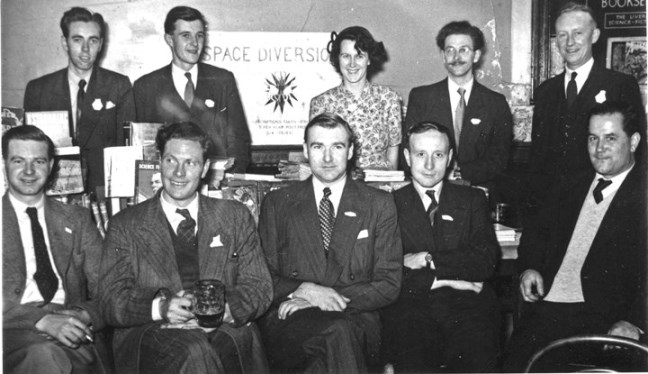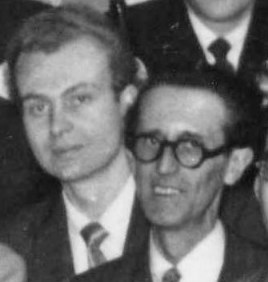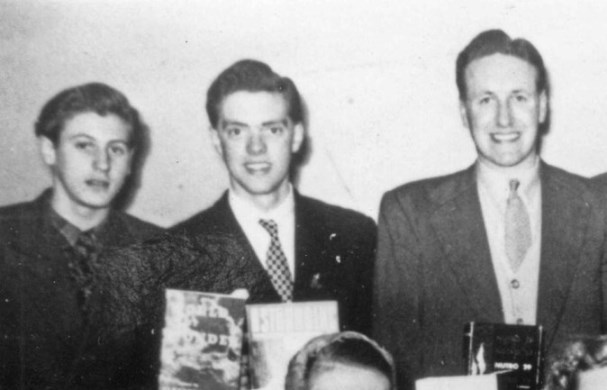
The 1952 MANCON, our second postwar regional convention (after the previous year's NECON), was held at the Waterloo Hotel, Hightown, Manchester. Though originally announced for 28th September, it was eventually held on Sunday 5th October. The committee were Dave Cohen, Eric Bentcliffe, Frank Simpson, Sid Klepper, Bill Jesson, and Sandy Sanderson. Who did what was not listed. Unusually, the only available photos from the con are all line-ups of the various fan groups present. These were intended for a post-con souvenir book that doesn't appear to have materialised and are from various collections including those of Eric Bentcliffe (eb). Norman Shorrock (ns), and Derek Pickles (dp). A gallery of headshots has been harvested from these, link below. There weren't a lot of reports written about the convention, this composite being based on Sandy Sanderson's from CAMBER #1 (Summer 1952, ed. Fred Robinson), interspersed with extracts the one by John Roles (presumably) in SPACE DIVERSIONS #3 (Oct 1952), and Paul Sowerby's in POSTWAR (Winter 1952, ed. Vince Clarke) which was a letter supplement to Vince's SCIENCE FANTASY NEWS - links to fanzines here. The commentary by Walt Willis was taken from his column in NEBULA #2 (Spring 1953, ed. Peter Hamilton). For such a short one-day con that didn't get started until after noon, the event was over-programmed and so, predictably, a number of items listed in the Programme Book had to be dropped including one or possibly two (exactly what the Sid Klepper/Bill Jesson 'Expose' was is unclear) dramatic productions. Presumably a script or scripts existed for these but if so they do not appear to have been published anywhere. My thanks to Greg Pickersgill for his help with this one. If you haven't already done so, you should visit his website. Some useful and interesting fanhistorical stuff there.
FIRST SESSIONH.P. 'SANDY' SANDERSON:HIC! - BEING AN ACCOUNT OF MY IMPRESSIONS OF THE MANCON! WRITTEN ABOUT BY AND FOR - ME! At long last the oft heralded day arrived. The only Sunday morning on which I have been awake at 8:00 am, and me on leave too! I staggered down to the Waterloo Hotel at approximately 10:00, and met a rather worried looking Eric Bentcliffe. Seems some character had been trying to tell him that the clocks were put back an hour the night before. We were just going to look for some other members of the Mancon committee, when we saw Frank Simpson coming along, so with him we turned, and entered the Hotel. Frances Evans had just arrived, and between us we started to arrange chairs and tables etc. John Brunner, the stick upon which Peter Hamilton of NEBULA leans, was staying at the Waterloo. He had travelled to Manchester the night before just to hear the Saints Jazz Band at the Grosvenor Hotel, Deansgate. He must have been disturbed by the noise we were making because he popped his head in the door but when he saw how hard we were working he sort of disappeared for a while. The Junior Fanatics also arrived early and we grabbed them before they could make a getaway, to help with the tables and chairs. PAUL SOWERBY: I was wandering around chatting to old acquaintances, giving a hand here and there with various stalls, when a good-looking be-spectacled man in a blue suit arrived. A glance at his label informed me that he was Harry Turner, former NEW WORLDS and TALES OF WONDER artist, whose best work, however, was featured in his early-war-time fanzine ZENITH, and was really good. I had tried to get in touch with him to lure him back to fandom a fortnight before without success, and so was pleased to see that the MANCON publicity had reached him after all. ((ZENITH, the 'zine with the best art-work of any duplicated effort that we've seen, is being revived by Harry Turner in co-operation with Derek Pickles... date of first issue uncertain)) He was accompanied by another fantasy artist, John White, who also amuses himself with half-stories. Unfortunately, they are first halves, like mine, so a fleeting hope of a coalition fell to the ground. Hasn't anybody got any second-halves?
SANDY SANDERSON: At approximately eleven o'clock the scene was set, and nearly all the exhibitions were ready. Of these there were eight, the best two being the Millcross (they seemed to have brought the shop with them) and Mike Rosenblum's selection of "Science Fiction before 1900". The other exhibitors wore Fred Fairless (a collection of books and book covers from the Operation Fantast Library), John Brunner (Nebula No. 1 plus two original illos to be in No. 2), Terry Jeeves (Fantasy Art Society Calendar for 1953 and some of his own illos). The Liverpool Club (Space Diversions), Grayson and Grayson Publishers (six of their books, which were later auctioned), and our own little show, including our fan mag Space Times, the Checklist, and some fantasy leatherwork by Eric Jones, our printer. JOHN ROLES: THE LIVERPOOL PARTY, numbering nine, arrived at the convention hall at approximately 11 a.m., and after feverishly assembling our own displays (Milcross Book Service and Space Diversions), we found a little time before the commencement of the opening session, to wander round and meet the other Mancon members. Incidentally we heard a new angle on the finding of club premises, from a Leeds member. One wanders round in search of a hotel with dirty top windows. This means an empty room. Go in and enquire. They'll give it to you. (!) Anyway that's how Leeds got their premises. Just before the opening session our secretary arrived, having missed the early train. He was just in time to hear the opening address by Dave Cohen, who introduced some of the more well-known fans and pros who were present. SANDY SANDERSON: Quite a lot of people had come in by this time, and Frances and Bill Jesson were at the door relieving them of money. There were not enough however to start the proceedings at 12:00 as advertised, so the informal period was extended to 12:30. By this time a large contingent from Bradford had improved matters immensely, the bar was open, I had a double scotch in my hand, and the programme got under way.
PAUL SOWERBY: Though people were still arriving and some things weren't quite ready, Dave Cohen took the stage, struggled with the mike, and gave warning that the Con was about to commence. Everybody - except those leaning on the bar - having taken seats, he announced Frank Simpson's talk on 'Alien Life Forms'. SANDY SANDERSON: First Dave Cohen introduced various celebrities, John Brunner (bow down, he's sold a story to ASF), The Junior Fanatics, Norman Weedall for the Liverpool Group, Derek Pickles for the Bradford group, and Harry Turner, who during the war was co-editor and cover illustrator for Zenith, just about the best fanmag of the time. Next came the members of the Committee; Dave himself, secretary; Bill Jesson, Chairman; Eric Bentcliffe, Editor; Eric Jones, printer (of Space Times); Frank Simpson, Librarian; Sid Klepper, Treasurer; Frances Evans, B.E.M. (she says its Brown Eyed Maiden); and yours truly. Just at the end of the introductions, seven or eight other people came and were introduced as John Russell Fearn. Next on the agenda was a lecture from Frank Simpson titled "Alien Life Forms". For this he required the aid of a blackboard, which did its best to be awkward. The lecture, which I believe will be in the Souvenir Booklet, was supposed to be the result of some amazing experiments carried out by a French scientists. PAUL SOWERBY: Frank gave the names of several French scientific journals as references, proceeded with detailed descriptions of a French scientist's experiments on the tolerance of extreme conditions by terrestrial life, concluding by giving said scientist's conjectures on the nature of Plutonian life... a roughly cylindrical creature, about 1000 miles in diameter (of necessity due to its metabolism), the greater part of the bulk being the vacuum of space, and the metabolism being based on the continued creation of matter in space. And we all sat there and lapped it up... even I! I beat my head against the wall, I tear my hair. I must have been day-dreaming... because the whole thing was one glorious spoof! SANDY SANDERSON: It was very well done, and I daresay there were many who didn't spot the hoax until it was well under way, but I can't help feeling it would have received better attention if it had come later in the programme instead of at the beginning. The lecture was followed by a game of Twenty Questions between a Liverpool Team comprising John Roles, Norman Shorrock, Lewis Conway and Stan Nuttall, and a Manchester Team of Eric Jones, Eric Bentcliffe, Terry Jeeves and myself. First object was "A Dan Dare Tie" which the Liverpool team managed to get, only to find out that it was merely a test object. Question Master Frank Simpson then got down to the real job. 'Vulcan' went to Manchester in 17, 'Imagination' to Liverpool in 20. For some obscure reason the time had now got to 1:30, so a halt was called for lunch. PAUL SOWERBY: We found a meal in a little cafe three hundred yards down the road; my table was composed of the Liverpool group, one Bradfordian, and self. We had quite a pleasant discussion on - you miss your guess - philately! All my fault, really, through asking Norman Shorrock why he'd used Edward VIII stamps on a packet to me; answer - they are valued in bulk below face value! ((To hard-up fans; we understand 'bulk' means BULK... thousands.))
SECOND SESSIONSANDY SANDERSON:We got back at 2:30 to receive the worst shock of the day. The bar was closed till 7:00 at night. However, we carried on with the Twenty Questions. 'Fandom' went to Liverpool in 16, and the last, 'Private Eye' was managed by Liverpool in the last second, almost as the gong was about to be gonged. One of the most interesting features of the day came next (at approx. 2:40). This was the talk on Anglo-fandom given by Mike Rosenblum. In this he stated that it is generally accepted that Anglo-fandom began with Walter Gillings, although perhaps he could go a little further back and say it all began with a letter to AMAZING in 1926 from John Russell Fearn. However, Walt Gillings was the one who was really in touch with the early American fans. At this time, astronomical societies played quite a part in the growth of fans, forming a meeting place for many S.F. minded people. On April 1st 1935 the Science Fiction League was formed in Leeds. This was the local chapter (No. 17) of the organization run by Wonder Stories, and was the first to be formed outside the United States. In January 1937 the first Convention was held in a hall in Leeds. People besides the local lads included Eric Frank Russell, Les Johnson (Liverpool), A.C. Clarke, Ted Carnell and Walt Gillings. It was decided at the convention to form a world society to be known as the Science Fiction Association. It was hoped that this would take over the American fans, and surprisingly enough it did, because it came at a time when the fans in America were getting tired of the magazine run clubs and leagues. This lasted till 1939, when the war put an end to it. Contact between fans was kept up by chain letters originated it is believed by A.C. Clarke. Mike Rosenblum himself was trying to keep up a fan mag, the FUTURlAN WAR DIGEST, and was proving just a little too much for him, when the British Fantasy Society was formed, purely as a temporary measure. This came to an end with the war in 1945 and elaborate plans were made for reviving the old Association, but they never came off. Since then, the main group has been the highly informal London Circle, members of which can be found on Thursday night at the White Horse, Fetter Lane. Our own club, the N.S.F.C. was one of the first to be formed outside London. At the end of his brief outline Mike was joined by Derek Pickles and Eric Bentcliffe, and the three answered questions fired at them. First question was "Is present fan activity up to the standard set before the war?". Mike said that it is building up to it, but as yet there is neither the experience nor the literary ability of pre-war fandom. Eric didn't quite agree, he pointed out that the number of fans who are quite open and willing to come forward has increased greatly since the war. We are, it seems, far more respectable now. Next question. "Have the films made S.F. more popular?" Mike again spoke first, and said that many S.F. films and books were made before the war, but they were not recognized as such. There was little classification before the war. Nowadays they are helping to a certain extent. (At this point, a cat brought, I believe, from London at great expense, strolled onto the scene.) Reverting to the first question re fandom, Frank Simpson from the floor said that the increased respectability of S.F. was obviously due to the V2s and Atom bombs. Eric, still insisting that there are more fans now than before war, said that this was helped by improved transport. Stunned silence from all those who had travelled on British Railways. Taffy Williams (the ASF Memory Man) now entered the argument, and pointed out that when he tried to contact active fans after the war, he found that they were no longer active, and it took till 1949 to improve matters. Mike had the last word, however, because he pointed out that most fans are young, and when they get a little older they have a tendency to get married, raise a family etc. and consequently cannot be so active as they would like. Their places should be taken by other young fans; during the war, however, the Forces were taking all the young fans, and there were no replacements for the old guard. That's why there was a gap after the war, and why fandom now is only just building up into the force it was pre war. The point was then dropped, and Paul Sowerby asked the third question, "Who, What, Where, Why etc. of Operation Fantast". Derek Pickles answered this by saying that O.F. was started by Ken Slater, purely as a trading mag. American mags at one time used to come over as ballast in ships, but not during the war. O.F. was intended merely as an exchange market to enable the English fan to get American mags. Since then it's just grown, and grown, and Ken has continued it as a non profit making concern ever since.
Next came the visiting celebrities. John Russell Fearn spoke first, and he turned out to be a very nice friendly sort of character. In answers to an absolute barrage of questions, he released the following information - He enjoys writing S.F. and has done so for about 25 years. The pseudonym Vargo Statten was his publisher's idea, not his; he doesn't like it, but as he's under contract there's nothing he can do. Astron del Martia is another of his names, but he only wrote one story under it, "The Trembling World'. The rest are not his. The Vargo Statten tales are turned out at the rate of three a month, each one comprising 40,000 words, taking eight days to write. It's a full time job even when they are not accepted. He sometimes finds it difficult to find time for a shave. When asked about his best story, he said "Annihilation". This despite the fact that it was turned down by about three American editors. He admits to a little plagiarism and occasionally writes someone else's plots from the middle out. Asked if he ever found time to read his own work he retorted. "I wouldn't read them if I could find time". His pseudonyms number fifteen, including all sorts of writing. There are about eight for S.F. He said that his stories are written as they are on the publisher's orders. A plot that would be leapt at by American editors can't be sold in England. (What about NEW WORLDS Mr Fearn?). His publishers insist he write down to the public. As these books apparently sell, it seems to indicate that they are bought by the younger element who are not in S.F. Clubs. He also blames the publishers for his habit of destroying the Earth. Apparently the first story using that theme went down so well they asked him to keep it up. (A competent psychiatrist might be able to make something of that) However he says the trend is coming to an end. Asked if "Laughter in Space" was a printing mistake for "Slaughter in Space", he said that a sub-editor had a wonderful idea round about the time he was writing that. He was going to add more pages, illustrations etc., and he asked for 80,000 words. When the story was written he found that the sub-editor had been sacked because his ideas were not liked. The 80,000 words were cut to the normal 40,000, and the result was "Laughter in Space". Reverting back to pen names, he does insist that Thornton Ayre is not one of his. Apparently it belongs to a friend of his, Frank Jones. Mr. Jones does a lot of travelling , and he leaves his MSS with JRF. Publishers sending cheques to JRF's house must have assumed he was Thornton Ayre. Mr. Fearn then left the stage during a well deserved round of applause.
The other personality was John Brunner, who I have already mentioned as having sold a story to ASF. He has been giving Peter Hamilton a hand in getting out the new S.F. mag NEBULA, and he told us quite a bit about it. Peter, who is 19, left a nursing home only last April, and was asked by his father what he intended doing in the line of work. As his father is a printer he said he'd edit a mag. Just like that. He got several stories lined up, and then began hitting the snags. The lead novel turned out to be too long, which is perhaps just as well, because he cut out about 30,000 words of the stuff that is illustrated by AMAZING's covers. He was going to print 20,000 copies at first, but on John's advice reduced that to 15,000 (this was the figure that Bert Campbell gave for AUTHENTIC). The idea behind the mag is to help new authors, and starting with the second issue, new artists. The two main snags that cropped up were 1) No distributor. 2) No advertiser. Peter is moving Heaven, Earth, and Scotland in an attempt to get a distributor, and Kemsleys in Glasgow are helping with advertising on an 'only SF mag edited by teenagers' slant. I personally wish them every success.
Following John, at 4:00 came the play "1966 and All That". This was
very good, and was quite well acted. The tape recorder used for a
wireless, however, was a little low. The play consisted of a small
group of club members meeting in 1966 to hear the broadcast of the
American rocket landing on Mars. Before the broadcast they discuss
alien life forms. I must say that Brian Varley was very good as the
neo-fan (I must say it, he's bigger than I am). The broadcast then
came on, and we heard the Americans landing, only to be met by a
chappie with a message from the skipper of the "MANCUNIAN" which had
been waiting for the Yanks ever since the last but one opposition.
Somewhere about here, whilst we were playing Fantasy Charades, our
mystery visitor wandered in. It looked very much like the 'Man from
Planet X' and it walked round, knocking over chairs etc. Rather an
amusing idea, I thought.
JOHN ROLES:
Fantasy Charades. Fans participating were John
Brunner, Derek Pickles, Frank Simpson, Ken Potter and Eric Bentcliffe.
Rather feeble, but relieved by the appearance of "the mysterious visitor"
(Bill Jesson attired in a suit 'Man from Planet X' style). This, after
the great publicity and build-up before the con came as something of
an anti-climax.
SANDY SANDERSON:
The auction followed; there were lots of mags and books for sale, and
quite a lot of the original artwork from NEW WORLDS and SCIENCE
FANTASY donated by Ted Carnell. Derek Pickles who betrayed a great
interest in Hunter, by buying nearly all his illos, also gave us a
hand with the actual auction. It's a shame Ted Tubb wasn't there, but
Derek did very well. Between 5:20 and 5:45 we adjourned for the
Buffet, which was agreed by all as being excellent and a big
improvement over other Cons.
The auction was renewed after the Buffet,
and it terminated at 6:45. Photos were taken of various groups, and
two large ones of the entire hall were taken for the cover of the
Souvenir Booklet. This took till 7:00 at which they were open again,
and I was able to make up for a very thirsty afternoon. I finally got
settled again with a double Scotch in time to hear Eric Bentcliffe ask
Terry Jeeves and Eric Jones to name the three people they would want
to have with them if they were marooned on an asteroid. Terry thought
first of three Bergey cover girls, but when he realised that unlike
the cover of a certain mag he would not be able to remove his space
suit he gave up the idea. Instead he chose one of E.E. Smith's
characters who could twist a few strands of wire and a bit of putty
etc and make anything, including a space ship. I forget just which
character he picked, but as all Doc Smith's characters can do that
trick (except the women), I don't think it really matters. Second
choice was G. O. Smith, who is also good at that sort of stuff. Terry
muttered something about a matter transmitter oscillating a perfect
square wave etc. Third choice was Eric Bentcliffe, as he was
responsible him being there, and if he wasn't able to get off, he
could knock hell out of Eric. Eric Jones then got up and said that as
Terry had pinched all his ideas he'd have to think for a minute or
two. First choice was Rick Drake, who seems to do well on asteroids,
especially seetee ones. Second choice was Isaac Asimov, because he
said that if he was there any length of time he'd have to build a hut
of some sort, and Asimov could ensure a 'foundation' (Ugh!). Third
choice was 'Ole Doc Methuselah' who could cure them if they were hurt
at all.
By this time the projector for the films had been set up, and as it
only needed a few final adjustments, the time was spent taking more
photos. I grabbed a couple more whiskeys and at 7:30 the films began.
First there was 'The Atom Bomb', which wasn't too bad.
JOHN ROLES:
The absence of sound spoilt what was a fairly good performance.
Considering the film must have been made on the tag end of a boot-string budget, its virtue far outweighed its faults. One scene, where a hen-pecked husband gets himself a willing girl-friend during the blackout, was masterly in its undepicted implications. There was also a spaceship that went via the Moon to Mars (which planet incidentally looks remarkably like St. Annes-on-Sea). What it was doing in the picture at all was not too clear. SANDY SANDERSON: 'Black Saturday' [was] produced by John Russell Fearn, and directed by Pete Ogden. This, although very amateurish, was well done. The story concerned itself with the effect that the darkening of the world had on various people. There seemed to be rather a lot of horrible men leering lecherously at young women, which caused quite a few comments, some humorous, some not, and far too many directed at me. It was during the film, whilst a fellow was trying to get a girl drunk, that a great idea struck me. Many people in S.F. have their deities, Foo Foo, Ghu, and Klono among them. Now I know the truth, they are all false. There, is no Ghod but HIC! and Scotch is his prophet. People are always praying for his forgiveness, although they don't know it. They are always spying HIC! Pardon me! The light has dawned! Anyway, back to the film. Despite the various comments it went down very well, and our thanks are due to JRF and Pete Ogden for the opportunity to see something new. It finished about 8:40, and as most people had to get away early the Con began to split up. Another cup of tea was provided for anybody who could manage a minute or two before going. The Millcross people and our own lads then settled down for a little natter, and round about 9:45 and two doubles later we broke up completely. PAUL SOWERBY: After the film, nearly everybody went. Just like that. Well, you can't have a Con. with nobody, so we all started to pack up. It was only 9.30 too. Conversations went on while the Hall was being cleared, but soon there was nothing left to read or do, so we... all... went... home. We were dead tired, but Eric Jones and I were still talking at midnight.... SANDY SANDERSON: Looking back, I think it was a great success for a first effort, and something the club can be proud of. True, the planning was bad, three items on the programme had to be dropped because of lack of time, but that can and will be corrected next time. There will be a next time. JOHN ROLES: The MANCON was a success. In spite of the fact that few fans attended from more distant parts, about eighty attended. Noticeably absent were representatives from London, especially after the many promises of support made earlier this year at the Loncon. INTERNATIONAL conventions held outside London cannot be successful as it is obvious that the attendance, particularly of well known celebrities, would not merit it, which is a view held by most Liverpool fans since the question was raised. Although our sympathies would be for an international convention held somewhere in the Midlands by reasons of convenience etc., logic dictates otherwise. Finally we wish to compliment the Mancon Committee on their arrangements and programme, (the actual Mancon Program was similar to the Loncon production by the way, and was illustrated with thumbnail sketches. We do think though, that the artist might have sharpened his thumbnail first!) Events ran smoothly, although a few listed items were omitted (Mancon Awards, etc. ) We shall look forward with pleasure to the institution of an ANNUAL MANCON.
WALT WILLIS: A couple of months ago I was a guest at the biggest science fiction gathering of all time, the Tenth Anniversary World Convention in Chicago. One item of topical interest to us was the voting for the site of next year's convention. This really was fiercely contested, and the San Francisco group spent some $800 propagandising their cause only to see the nomination go by a narrow majority to Philadelphia. I can't imagine this happening in Britain, where there's neither the enthusiasm nor the money, but we are beginning to have the same problem since the rise of powerful fan movements in the North of England. The trouble here is that while the Northerners have the energy and the ability to put on a convention, their cities lack the tourist attractions of London and the fan attractions of its famous authors. And that it seems as hard to bring one up North as the other. At any rate no Londoners showed up at the recent Manchester Convention. There's been some resentment about this in the North but the reason was nothing more than London lethargy plus the firm conviction that there was nothing up North that there wasn't more of at home. However as a local gathering the Mancon was a success. About 80 people attended, mostly from the Liverpool and Manchester areas. The lion of the affair was John Russell Fearn, who very sportingly, came out of his den to be bearded. In a lively question and answer session Fearn, who is also Vargo Statten and some fourteen other pocketbook authors, frankly admitted that he wrote down to his audience because he didn't believe there was a market in Britain for good science fiction. It's up to us to show him otherwise. Fearn also showed a film he had made and acted in himself, and generally heaped coals of fire on fandom's head for some of the harsh things it has said about him. The only other professional author present was eighteen year old John Brunner, who has just sold a thousand dollars worth of fiction to American markets since his first story appeared in SLANT a year ago. He reported on the progress of NEBULA to an audience eager to do all they could to help. The rest of the Mancon programme was put over with such efficiency as to prove that the organisers are quite capable of putting on a National Convention and need only the material to work with. Whether they get this or not depends on the London Circle, who will have to make up their minds soon whether to continue to hold the Convention themselves or give their wholehearted support to the North.
| ||||||||||||||
|
||||||||||||||
